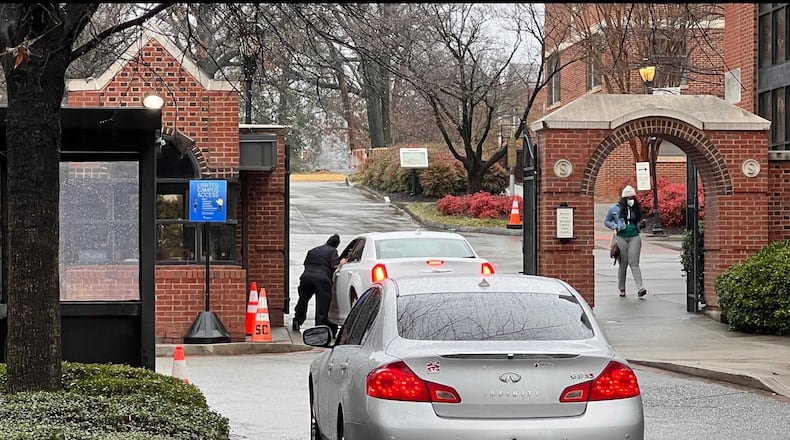Albany State University sophomore Eyanna Vereen was in her apartment across the street from campus this week when her phone starting buzzing with calls and text messages from her mom and friends who heard about a bomb threat at the school.
Vereen soon saw messages from the university urging students who weren’t on campus not to come there. Outside her window, she spotted police cars and a fire truck on campus.
“My mind was blown,” said Vereen, 19, a business management major. “Is this really happening? Is this really a bomb threat?”
Credit: Photo Credit
Credit: Photo Credit
Albany State is one of three historically Black colleges and universities in Georgia to receive bomb threats this week, along with Fort Valley State University and Spelman College. For Spelman, the prestigious women’s college near downtown Atlanta, it was the second threat this year.
In all, about two dozen HBCUs nationwide have received bomb threats this year. Scholars say the number of threats is unprecedented. No devices thus far have been found.
“These threats are despicable. They are designed to make us feel fearful and vulnerable,” Spelman President Mary Schmidt Campbell said in a message posted on the college’s website.
HBCU students and supporters are calling for more security at the schools, and some campuses have added extra measures, such as requiring students to use their ID to enter some campus buildings. Atlanta police are doing extra patrols around the city’s HBCUs. They also want a full and transparent investigation, but worry federal authorities won’t take the threats seriously.
The FBI, partnering with 20 field offices nationwide, is investigating the threats as hate crimes.
For many, the threats are viewed as part of a long history of domestic terrorism against Black Americans and institutions. That history includes the 1963 church bombing of the 16th Street Baptist Church in Birmingham, Alabama; arson fires at Black churches across the South and, more recently, the 2015 mass shooting at Emanuel AME Church in Charleston, South Carolina.
“It’s in our psyche. It’s continuous, but we carry on through this,” said Raymond C. Pierce, president and CEO of the Atlanta-based Southern Education Foundation. He’s a former dean of North Carolina Central University’s law school, an HBCU.
HBCUs, among the most revered institutions in the Black community, have been here before.
“Knowing where we came from, it is amazing that we are still dealing with these issues,” said Mike Collins, a 42-year-old strategic planner living in Atlanta. “But it shows us how far we still have to go in America to get justice and peace as African Americans.”
Collins was a sophomore at Florida A&M University in 1999 when two pipe bombs exploded.
The first bomb ripped through a first-floor bathroom inside an auditorium. No one was hurt, but a month later, a second bomb exploded, shaking the Black college to its core.
“To experience something like that was scary and we didn’t know what it stemmed from or where it was coming from,” Collins said. “What we did know is that they were targeting us because we were Black. It was terrifying.”
Lawrence Lombardi, a white supremacist who admitted that the bombings were racially motivated, was sentenced to 54 years in prison.
While no one was injured in the bombings, the school saw a significant decrease in enrollment because of fear, officials said.
Hate crimes have largely increased on college campuses during the last decade, FBI statistics show. More than 40% of hate crimes on college campuses are racially motivated, according to federal education data.
Pierce said the threats are traumatizing for many Black Americans — reminders of other experiences of racial discrimination. Howard University in Washington, D.C., which has received three threats, closed Friday, declaring it a mental health day “in recognition of the additional challenges that have been heaped upon our shoulders.”
Pierce, a former U.S. Department of Education civil rights office administrator, said some whites resent the existence of HBCUs, which, in most instances, were founded at a time when colleges wouldn’t admit Black students. He recalled seeing threatening emails and letters when he was at North Carolina Central.
“Attacks upon HBCUs — which are the pillars and incubators of Black intellectualism, leadership, and culture — are deeply racist and must be quickly and vigorously investigated,” he said.
First-year Spelman College student Lindsey Fiesta was in her room on campus when she was alerted about the most recent bomb threat. She rushed to a friend’s room, in part, because she didn’t want to be alone.
She’s concerned the threats may deter some students from applying to HBCUs.
Credit: Eric Stirgus
Credit: Eric Stirgus
“HBCUs are a symbol of Black people being educated and breaking stereotypes,” said Fiesta, 18, a psychology major from Boynton Beach, Florida. “A lot of people want to tear that down, and that really scares me.”
Staff writer Tia Mitchell contributed to this article.
Keep Reading
The Latest
Featured






